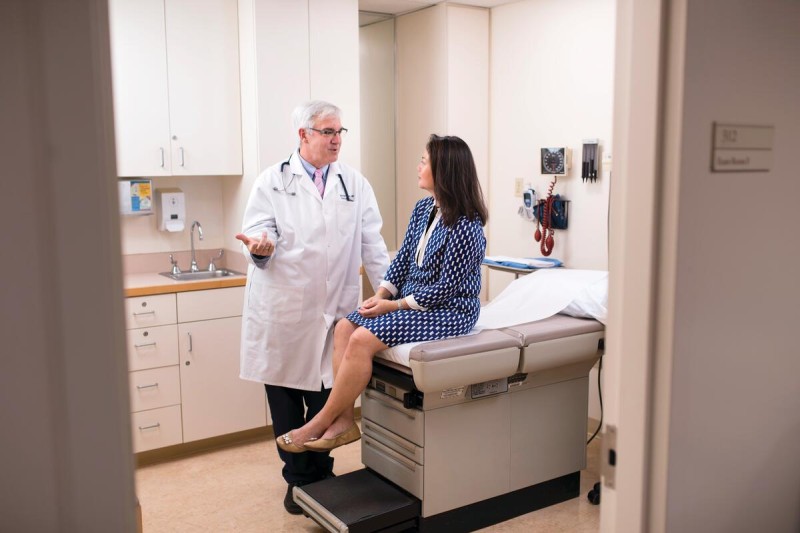
Advances in cancer detection have saved many lives, but they have a serious drawback: Some cancers are being overdiagnosed, which can lead to the unnecessary treatment of tumors that would have posed no threat if left alone.
One cancer that may not need treatment right away — or in some instances, ever need treatment — is papillary thyroid cancer. For many people with this type of tumor, doctors at Memorial Sloan Kettering Cancer Center (MSK) recommend a course of action called “active surveillance,” also known as “watchful waiting.”
Through MSK’s active surveillance program, patients receive regular scans and physical exams. Since the program was launched in 2012, studies have shown that the vast majority of enrolled patients have never seen their tumors grow. By participating in the active surveillance program, these patients avoid unnecessary surgery and the risks that come with it.
“For those people whose tumors do eventually grow, they are still able to receive treatment,” explains Michael Tuttle, MD, Chief of MSK’s Endocrinology Service. Outcomes for patients in the program who delay surgery are just as good as they are for patients who have treatment right away.
Below are answers to common questions about papillary thyroid cancer and information about why active surveillance is a good option for many people with small thyroid tumors.
What is papillary thyroid cancer?
Papillary thyroid cancer is the most common type of cancer found in the thyroid gland. It makes up 80% to 85% of all thyroid cancers. Some studies suggest that up to 10% of the population has small tumors, or nodules, in their thyroids, even though most people don’t know it.
Papillary thyroid cancer arises in cells called follicular cells. These cells make hormones that help regulate your metabolism, heart rate, blood pressure, and body temperature.
What are the symptoms of papillary thyroid cancer?
Papillary thyroid cancer usually doesn’t have any symptoms. When it does, the most common one is a lump that can be felt in the thyroid gland — located in the front of the neck, just below the Adam’s apple.
What is the prognosis for papillary thyroid cancer?
Papillary thyroid cancer is very treatable. It rarely spreads to other parts of the body.
Why did MSK establish the active surveillance program for papillary thyroid cancer?
In the past three decades, cases of papillary thyroid cancer have more than doubled. That’s not because this cancer has become more common, but because more sensitive tests make it easier to find very small tumors. The tests include ultrasounds, CT scans, and MRI scans. In many cases, these tests are done for unrelated reasons, and the discovery of a thyroid nodule is an “incidental finding.”
“When someone learns they have cancer, it is distressing to hear,” Dr. Tuttle says. “They usually want it out of their body before it grows and spreads. But most of these small tumors are unlikely to ever progress and cause problems. With a slow-growing cancer that’s not likely to be fatal, it is very important to question whether immediate surgery is required, especially if it could harm quality of life.”
Why is active surveillance better than surgery for most patients with small papillary thyroid tumors?
No surgery is without risk. MSK’s surgeons are very experienced, and complication rates at MSK are low. But surgeons at other hospitals may have much less experience performing these operations. In rare cases, this surgery can damage the vocal cords or the parathyroid glands, which regulate calcium in the bloodstream.
Importantly, patients who have their thyroids removed will need to take medication for the rest of their lives. The medication is to make up for the loss of the hormones that the thyroid normally makes. “These medications can be difficult to adjust, and many people who take them describe feeling tired all the time,” Dr. Tuttle says.
How does MSK determine which thyroid cancer patients are candidates for active surveillance?
For small tumors that are contained within the thyroid gland, a careful review of the thyroid ultrasound, physical examination, and a discussion with the patient allow doctors to identify which patients are the best candidates for active surveillance. When patients with small tumors are eligible for active surveillance, the vast majority of those tumors remain stable or grow very slowly over five to 10 years. A few tumors do gradually enlarge during the first year or two of follow-up.
Patients enrolled in the active surveillance program will start having ultrasounds and exams every six months. If there is no change after two years, they will only need to come in once a year. Once these small tumors are shown to be stable for five years, ultrasound examinations are done every two to three years.
What happens if my cancer grows while I am in active surveillance?
“Depending on the rate of tumor growth and other factors, you may be able to continue with active surveillance even after your tumor grows,” Dr. Tuttle explains. “But if your doctor tells you that you will need surgery, success rates for this procedure are very high.” Most patients who get surgery for papillary thyroid cancer are considered cured.
